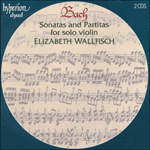The Partita in B minor (BWV1002) is outwardly, perhaps, the most straightforward and expressively undemonstrative of the three. It consists of four classical suite movements, though each has its own Double, or variation. The work begins with an Allemanda whose character is defined by angular, even seemingly awkward contours. By comparison, its Double is uncomplicated, yet here as throughout the suite Bach’s writing appears tinged with an underlying expressive melancholy. Following a brisker Corrente and its Double, marked Presto, is the Sarabande and Double, whose graceful gestures and noble eloquence establish its position as a focal point of the suite. The concluding Tempo di borea, or Bourrée, and its Double make effective use of sequences to extend phrases and to generate energy.
from notes by Nicholas Anderson © 2009
En apparence, la Partita en si mineur (BWV1002) est peut-être la plus simple et directe et la moins démonstrative sur le plan expressif des trois. Elle se compose de quatre mouvements de suite classiques, mais chacun d’entre eux a son propre double, ou variation. L’œuvre commence par une Allemanda, dont le caractère est défini par des contours angulaires, voire maladroits en apparence. En comparaison, son double est simple, mais ici comme dans toute la suite, l’écriture de Bach semble pourtant teintée d’une mélancolie expressive sous-jacente. Après une Corrente plus vive et son double, marqué Presto, les gestes gracieux et la noble éloquence de la Sarabande et de son double en font le point central de la suite. Le Tempo di borea, ou Bourrée, conclusif, avec son double, fait une usage efficace des séquences pour développer les phrases et créer de l’énergie.
extrait des notes rédigées par Nicholas Anderson © 2009
Français: Marie-Stella Pâris
Die Partita in h-Moll (BWV 1002) scheint zunächst das vielleicht überschaubarste und unkomplizierteste der drei Stücke zu sein. Es besteht aus vier klassischen Suitensätzen, obwohl jeder Satz ein Double, bzw. eine Variation, hat. Das Werk beginnt mit einer Allemanda, die eckige, fast ungelenk anmutende Konturen aufweist. Das Double dazu hingegen ist unkompliziert, doch scheint Bachs Stil hier, wie auch in den anderen Sätzen der Suite, von einer ausdrucksvollen melancholischen Grundstimmung durchdrungen zu sein. Auf die forschere Corrente samt Double, das mit Presto überschrieben ist, folgt die Sarabande mit Double, deren elegante Gesten und edle Eloquenz sie zum Blickpunkt der Suite machen. Im abschließenden Tempo di borea, oder Bourrée, und Double werden Sequenzen effektiv dazu eingesetzt, gewisse Phrasen zu verlängern und Energie zu erzeugen.
aus dem Begleittext von Nicholas Anderson © 2009
Deutsch: Viola Scheffel


 Bach: Sonatas and Partitas for solo violin
Bach: Sonatas and Partitas for solo violin
